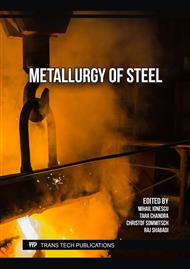p.1
p.7
p.13
p.19
p.29
p.35
p.41
p.47
Effect of Mo and Mo+Nb Additions on the Phase Transformation and Microstructure of a Developed Low-Carbon CrNiMnB Ultrahigh-Strength Steels with a Preceding Hot Deformation
Abstract:
The influence of molybdenum, and molybdenum with niobium addition on the phase transformation behaviour of a developed low-carbon CrNiMnB ultrahigh-strength steels, was investigated. Gleeble 3800 thermomechanical simulator was employed to simulate the hot-rolling process and to get the dilatation curves. After austenitization at 1250 °C for the complete dissolution of carbides, specimens received 0.6 total strain (i.e., 0.2 at 1100 °C and 2 x 0.2 at 900 °C) followed by cooling at various cooling rates (CRs) in the range of 2-60 °C/s. The final microstructures were investigated using laser scanning confocal microscopy, field emission scanning electron microscopy, and hardness measurements. Then the continuous cooling transformation diagrams were constructed based on the dilatation curves, microstructure, and hardness values. The electrolytic extraction method was used to assess the elements' distribution and the composition of the forming precipitates. The addition of Mo increased the hardenability, decreased the transformation temperatures, and promoted the formation of low-temperature transformation products i.e., martensite and bainite ferrite, at different CRs and inhibit the formation of polygonal ferrite. The formation of coarse precipitates neglected the effect of Mo+Nb addition, decreased the hardenability and expanded the region of BF formation to high CRs. The variation in the hardness with microstructural changes was discussed.
Info:
Periodical:
Pages:
19-27
Citation:
Online since:
November 2023
Authors:
Price:
Сopyright:
© 2023 Trans Tech Publications Ltd. All Rights Reserved
Share:
Citation:



